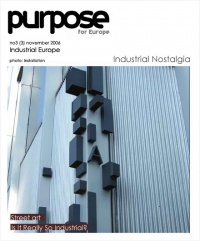
Feature
Is it really so industrial?
We no longer live in an industrial society, a factory (as a church before) is no longer the central instance that structures the space of social relations. Modern societies are no longer denoted by the relations of production – at least not so obviously as before. The concepts of „working class” and „capitalists” have undergone a peculiar change. The present time brought rather certain flow of roles that, although still show the material status, are no longer defined clearly and distinctly. Nowadays we all, to a greater or lesser extent, have become „workers” commissioned by impersonal „capital”. It is this „impersonality” or „virtuality” that are crucial here. „Employee” and „employer” have lost their – once clearly defined – identities. Post-modernistic societies are some kind of constantly changing „networks”, structures, where it is difficult to notice fixed, identical points. „Virtual capital” has made us all partly „employers” and partly „employees”. The roles are blurred, splintered. We are in the interface of the two worlds – the modernistic, industrial space organized by the employer-employee relations (let’s assume that a factory is the symbol of this world), and the world where everything that matters is the continuous flow of capital and information, where social roles are reduced to the operation of the computer interface (the perfect symbol of this world is the Internet). Many contemporary researchers propose such theses (e.g. Manuel Castells). I guess we just have to agree with them.
If post-modernistic societies are characterized by some „smoothness”, „speed’’, „virtuality”, how does this image influence the structure of the space of modern cities? In other words – what has happened to large factory buildings that, until recently, were our supervisors, organizers. If television and cinema screens, as well as computer monitors are becoming more and more important reference points (we have to notice a certain paradox in this observation – on the screens we can see literary everything, so EVERYTHING can be our point of reference - this is what the hyper-reality of the post-modernistic world consist in), what has happened to all the „relics of the past” which not so long ago helped us squeeze into strictly defined social roles?

illustration: Tomasz Kaczkowski
Most old factories are being „revitalized”. This trend, extremely common in Europe, reached Poland some time go. We could make a long list of old factory buildings turned into commercial-culture-entertainment centres (where – according to the spirit of the times – we can buy EVERYTHING). There are more and more of them. What is essential here is that nobody tries simply to restore them (which would mean reproducing precisely their original appearance) – „revitalization” that consists in adapting those spaces to the modern, consumer style of life, is much more important. Old factory buildings are turned into modern office blocks, shops, hotels, lofts. Nobody seeks nostalgia, history, they are not expected to build historic identity. Contemporary people don’t need historical monuments, their identity is not based on contemplation of the past. Cumulative approach, once so common, has been replaced by a functional, pragmatic one. While in the modernistic age people tried to build up identity reaching from the present to the most remote past (with that gesture trying to embrace as many phenomena regarded as significant as possible and to arrange them according to some universal hierarchy of values), postmodernism treats the past selectively, focusing on some „here and now”.
Researchers of culture name two symbolic figures to illustrate the above changes. One of those figures is a „labyrinth city”, a city where everything is structured around a centrally located identifying instance. In other words – there is „something” (a church, a factory, an office) in the centre of the labyrinth that gives meaning to the whole structure, makes it a solid creation. This „something” guarantees the identity of all the elements that constitute the structure. The figure of the „labyrinth” also makes us think about a „constructor” who, in turn, guarantees some rational perspective of the whole. The „constructor” is the supervisor and the master of the labyrinth.
The other figure is a „palimpsest city”. In this case the structure is not coherent – the image of the city consists of many cultural discourses, many different languages, contradictive solutions. Here the classic concept of identity is „splintered”, there is no central instance to unite the polyphonic structure of public space. Also the concept of a „constructor’ is negated – the „palimpsest city” belongs to everybody and work on it will never be considered finished.
The „labyrinth city” is a modernistic city, whereas the „palimpsest city” is a postmodernist one. Can we then speak about the „industrial” face of Europe? The nickname „post-industrial” is much more suitable here, even though it won’t explain fully the character of changes in the European spirituality. It is very symptomatic that all the old factory spaces are more and more often turned into „multifunctional” objects to facilitate the flow of goods, services, information. Information societies value speed, „smoothness” and the ability of changing social roles fluently, and therefore where they feel best is „nowhere”. Europe, as a part of the global village, is slowly becoming such „nowhere”, a „palimpsest city”, where some traces appear where others have been erased. It is hard to appreciate this cultural multiplicity and ambiguity. The „palimpsest city” is a challenge for contemporary man who – surrendering himself to the control of the virtual, hyper-real space of modern media – is likely to stop leaving any traces at all.
Check the archive

nr 26 November 2006
theme of the issue:
INDUSTRIAL EUROPE
< spis treści
Article
Industrial Europe
Presentation
Lofts
Anslysis
Industrial nostalgy - Artur Zaguła
Career in Culture
Atmosphere of nineteenth-century factories - conversation with Krzysztof Candrowicz
Industrial Culture
At Scheibler - interview with Dorota Urawska
Young Culture
Street art - conversation with Truth
Feature
Is it really so industrial? - Kuba Wandachowicz
On the margin
MAXIMALDesign - interview with Gert Verschueren





